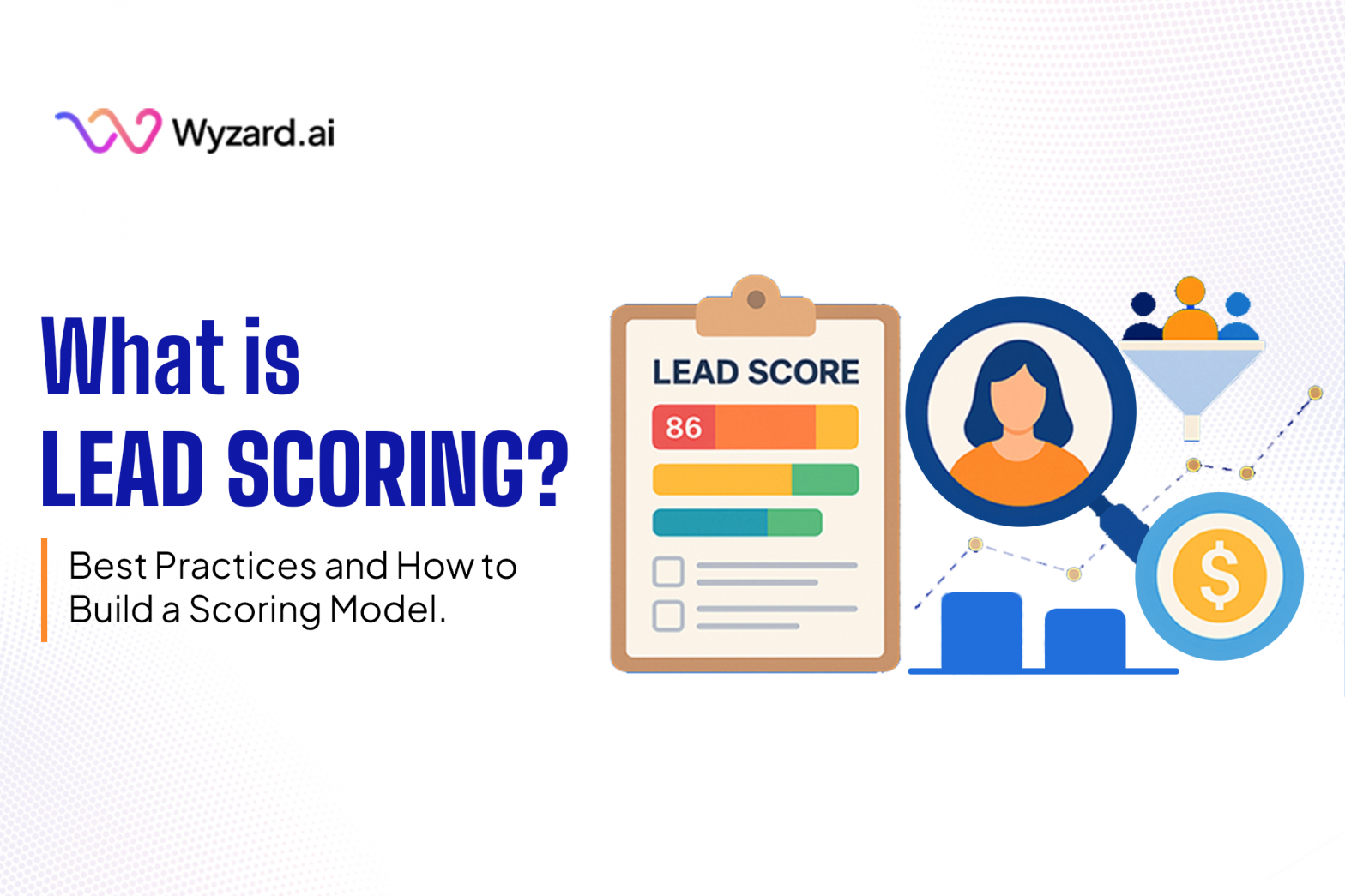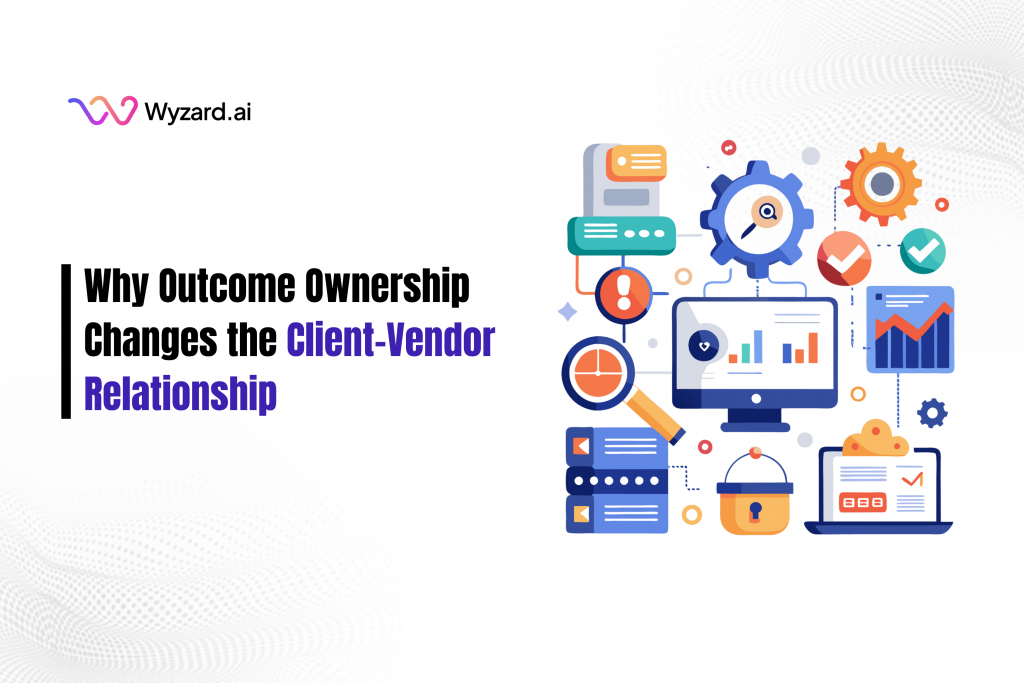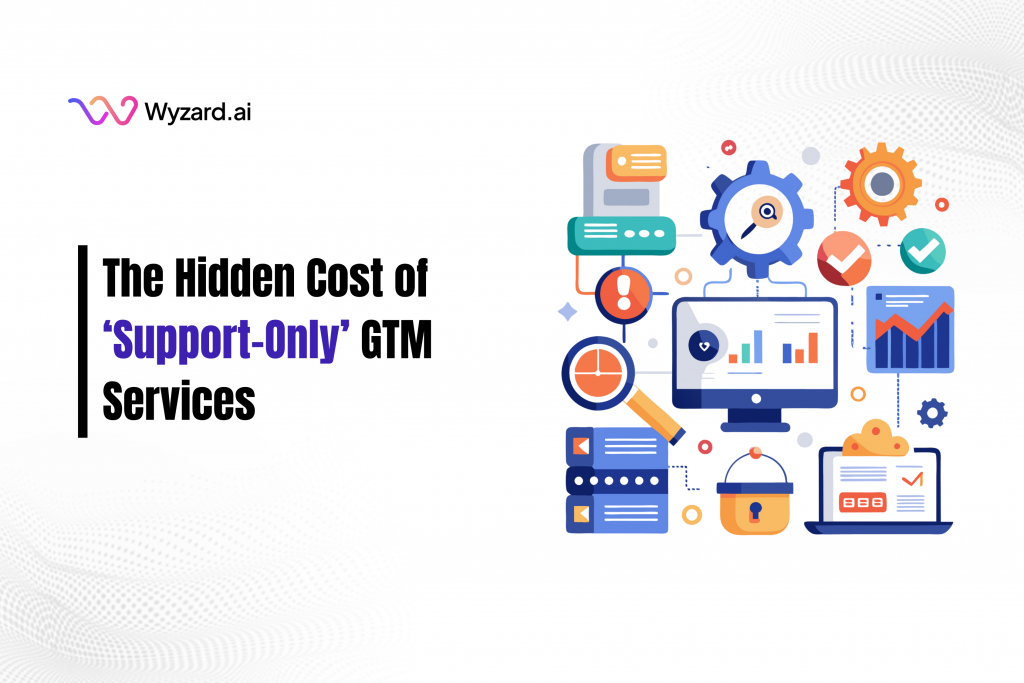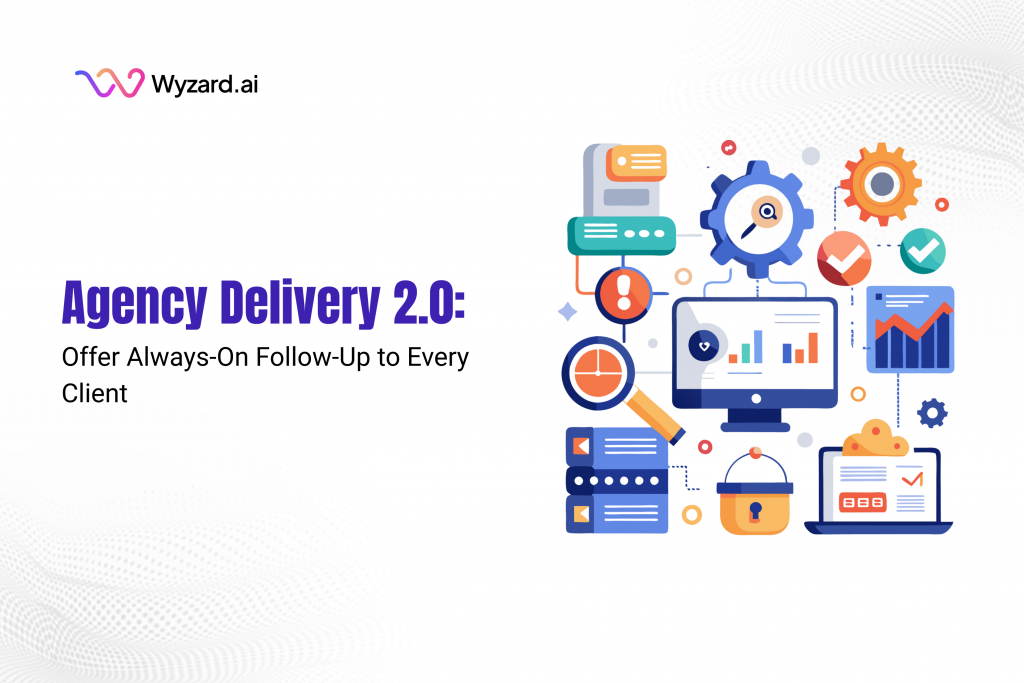A CMO signs a new GTM contract with high expectations. The tools look strong. The roadmap feels solid. The ...
What Is Lead Scoring? Best Practices and How to Build a Scoring Model


Subscribe Now
Imagine Sarah from Acme Corp just downloaded your pricing guide, attended yesterday’s product demo, and clicked “Talk to Sales”, clear buying signals. Meanwhile, John from Beta Inc. only opened a newsletter last month. Without lead scoring to prioritize engagement, your sales rep spends an hour chasing John while Sarah, frustrated by the wait, signs with your competitor. This happens daily across B2B sales teams.
Lead scoring transforms this chaos into strategic precision. Top-performing sales organizations use data-driven scoring models to identify which prospects deserve immediate attention and which need further nurturing.
Modern b2b lead scoring goes beyond basic demographics. Advanced systems analyze behavioral patterns, engagement depth, and intent signals to predict purchase probability with remarkable accuracy.
What is Lead Scoring?
Lead scoring assigns numerical values to prospects based on their likelihood to purchase and potential value to your business. Each prospect receives a score reflecting their demonstrated interest level and alignment with your ideal customer profile.
Traditional scoring focuses primarily on demographic data like company size or industry. Modern lead scoring best practices incorporate behavioral signals, engagement patterns, and intent data to create comprehensive prospect assessments. A prospect who visits pricing pages multiple times while downloading comparison guides demonstrates higher purchase intent than someone who reads general industry content.
Effective scoring models help sales teams prioritize their time and energy on prospects most likely to convert. Instead of responding to leads chronologically, teams can focus immediately on high-scoring prospects while nurturing others through automated sequences.
Why is Lead Scoring Important?
B2b lead scoring directly impacts revenue generation by ensuring sales teams focus their limited time on prospects with highest conversion potential. Without scoring, teams often waste hours qualifying prospects who lack budget, authority, or genuine need for your solution.
Scoring also enables better alignment between marketing and sales teams. Marketing can focus on generating higher-quality leads while sales receives pre-qualified prospects with context about their interests and behavior. Clear scoring criteria eliminate debates about lead quality and handoff timing.
Modern buyers research extensively before engaging with sales teams. Lead scoring captures and quantifies these research behaviors, helping teams understand where prospects stand in their buying journey. Armed with scoring insights, sales representatives can tailor their approach to match prospect readiness levels.
Instead of static point systems, AI-powered lead scoring reads behavior, fit, and timing together to surface the buyers most likely to move now.
Lead Scoring Models and Types
Different lead scoring models serve specific business needs and customer types. Most successful organizations combine multiple approaches to create comprehensive prospect assessments that account for various factors influencing purchase decisions.
1. Company and Contact Fit Models
Who your prospect is matters as much as what they do. Firmographic and demographic scoring work hand-in-hand: you might love that a prospect works at a 200-person SaaS company (firmographic gold), but if they’re a junior analyst with no budget authority (demographic reality check), your scoring should reflect both truths.
The sweet spot? A VP of Marketing at a fast-growing tech company beats a CMO at a Fortune 500 that moves at glacial speed. Your ideal customer profile determines these scoring weights.
2. Behavioral and Intent Signals
Modern lead scoring tracks both what prospects do and why they’re doing it. When someone visits your pricing page, downloads ROI calculators, and forwards your emails to colleagues, they’re showing buying behavior. Layer in intent data like researching your competitors, reading industry buyer guides, or comparing solutions across vendor websites and you’ve spotted someone in active evaluation mode.
The most powerful scoring combines these first-party behaviors (what they do on your properties) with third-party intent signals (their research activities elsewhere), automatically alerting sales when prospects shift from passive interest to active buying mode. Smart lead qualification systems track all these signals in real-time, ensuring you never miss a prospect heating up.
Lead scoring also plays a major role in GTM marketing alignment. Read here.
3. Lead Source Models
Source-based lead scoring recognizes that different acquisition channels produce prospects with varying conversion probabilities. Referrals typically convert at higher rates than cold outreach, while content marketing leads may require longer nurturing periods.
Content marketing efforts often attract prospects in early research phases, while demo requests indicate advanced evaluation stages. Scoring models should weight these sources appropriately based on historical conversion data.
4. Predictive Intelligence Models
Predictive lead scoring uses machine learning algorithms to identify patterns that correlate with successful conversions. Models analyze thousands of data points to predict which prospects are most likely to purchase within specific timeframes.
AI-powered systems continuously refine scoring accuracy by learning from actual conversion outcomes. As more prospects move through your sales process, predictive models become increasingly accurate at identifying high-potential opportunities.
5. Negative Scoring and Spam Detection Models
Negative lead scoring reduces scores for characteristics that indicate poor fit or low purchase probability. Prospects from industries you don’t serve, students using personal email addresses, or competitors researching your solution should receive reduced scores.
Spam detection models identify and filter out low-quality inquiries that waste sales team time. Generic contact information, suspicious email domains, or automated form submissions typically indicate spam rather than genuine prospects.
Pre-Implementation Considerations
Successful lead scoring implementation requires careful planning and stakeholder alignment before selecting tools or assigning point values. Organizations must establish clear criteria and processes that support their specific sales methodologies.
1. Define Sales-Qualified Lead Criteria
B2b sales prospect evaluation criteria must align with your actual sales process and ideal customer characteristics. Sales teams should define exactly what constitutes a qualified lead worthy of immediate attention versus prospects requiring additional nurturing.
Document specific qualification frameworks like BANT (Budget, Authority, Need, Timeline) or MEDDIC that guide prospect assessment. Clear criteria ensure consistent evaluation across team members and provide foundations for scoring model development.
2. Coordinate Across Teams
Lead scoring best practices require close collaboration between marketing, sales, and operations teams. Marketing teams understand lead generation sources and early-stage behaviors, while sales teams know which characteristics predict successful conversions.
Regular alignment meetings help teams agree on scoring criteria, point values, and handoff processes. Operations teams ensure technical implementation supports desired workflows and provides necessary reporting capabilities.
3. Talk to Your Customers
Customer interviews provide invaluable insights for lead scoring model development. Existing customers can explain their research processes, decision-making factors, and early indicators of purchase intent.
Understanding how customers evaluate solutions helps identify behavioral patterns that predict conversion likelihood. Customers often reveal research activities and content consumption patterns that sales teams never observe directly.
4. Turn to the Analytics
Historical data analysis reveals which prospect characteristics and behaviors correlate most strongly with successful conversions. Analytics help identify patterns that might not be obvious from anecdotal experience.
Review closed-won deals to identify common characteristics, engagement patterns, and conversion timeframes. Compare successful conversions with lost opportunities to understand what differentiates high-potential prospects from poor fits.
How to Calculate Lead Scores
Static scoring models decay quickly. What worked last quarter might fail today. At Wyzard, we use real-time buyer signals to adjust lead scores and launch timely actions automatically. When a prospect’s behavior shifts from research to evaluation, their score updates instantly and triggers appropriate engagement.
The best lead scoring isn’t about perfect point values, it’s about continuous learning and adaptation. Whether you’re starting with manual scoring or jumping straight to AI, remember that the goal isn’t the score itself. It’s using that intelligence to engage the right prospects at the right time with the right message.
Lead scoring calculation methods range from simple manual approaches to sophisticated machine learning algorithms. Most organizations start with basic manual scoring before advancing to more complex automated systems.
Manual Lead Scoring
Manual lead scoring assigns point values based on predetermined criteria and historical conversion data. Sales and marketing teams collaborate to identify important characteristics and assign appropriate weights to each factor.
Start by listing all available prospect data points including demographic information, behavioral actions, and engagement patterns. Assign point values based on their perceived importance and correlation with successful conversions.
Calculate Lead-to-Customer Conversion Rates
Conversion rate analysis provides the foundation for effective b2b lead scoring point assignments. Calculate conversion rates for different prospect segments, lead sources, and behavioral patterns to understand what predicts success.
Analyze conversion rates by company size, industry, job title, and lead source to identify highest-performing segments. Prospects from segments with higher conversion rates should receive higher base scores in your model.
Pick and Choose Customer Attributes
Select prospect attributes that most strongly correlate with purchase decisions and successful implementations. Focus on characteristics you can consistently capture and that significantly impact conversion probability.
Common high-value attributes include decision-maker job titles, company growth stage, technology stack alignment, and specific behavioral signals. Avoid attributes that are difficult to capture consistently or that don’t correlate with actual purchase behavior.
Calculate Individual Close Rates
Individual attribute analysis reveals which specific characteristics predict conversion success. Calculate close rates for different job titles, company sizes, industries, and behavioral actions to identify the strongest predictive factors.
Compare close rates across different attribute combinations to understand how factors interact. Marketing qualified leads from enterprise accounts might convert differently than similar leads from mid-market companies.
Compare Close Rates and Assign Point Values
Point value assignment should reflect the relative importance of different attributes based on their correlation with conversion success. Attributes with higher close rates deserve proportionally higher point values in your lead scoring model.
Create a points scale that differentiates meaningfully between high and low-potential prospects. Ensure your scale provides enough granularity to prioritize prospects effectively without creating unnecessary complexity.
Logistic Regression Lead Scoring
Logistic regression models predict conversion probability based on multiple prospect characteristics simultaneously. Mathematical models can identify complex relationships between variables that manual analysis might miss.
Statistical modeling requires sufficient historical data and analytical expertise but often produces more accurate predictions than simple manual scoring. Organizations with data science capabilities can implement sophisticated regression models that continuously improve accuracy.
Predictive Lead Scoring
Predictive lead scoring leverages machine learning algorithms to identify conversion patterns automatically. Algorithms analyze thousands of data points to predict which prospects are most likely to purchase within specific timeframes.
AI-powered lead qualification systems learn from actual conversion outcomes and continuously refine their predictions. As more prospects move through your sales process, predictive accuracy improves automatically.
Modern teams also rely on automated SDR systems to accelerate qualification.
Multiple Scoring Systems
Advanced lead scoring best practices often incorporate multiple scoring dimensions to provide comprehensive prospect assessments. Different scoring systems can evaluate various aspects of prospect quality and readiness.
Fit vs. Interest Scoring
Fit scoring evaluates how well prospects match your ideal customer profile based on demographic and firmographic characteristics. Interest scoring measures engagement levels and behavioral signals indicating purchase intent.
Separating fit from interest helps sales teams prioritize prospects who demonstrate both strong alignment and high engagement. High-fit, high-interest prospects deserve immediate attention, while high-fit, low-interest prospects might benefit from targeted nurturing campaigns.
Multiple Personas Scoring
B2b lead scoring models should account for different buyer personas involved in purchase decisions. Technical evaluators, economic buyers, and end users often demonstrate different behavioral patterns and require different approaches.
Create separate scoring models for each persona type to ensure appropriate prioritization and messaging. Marketing automation systems can apply different scoring logic based on prospect roles and responsibilities.
New Business vs. Up-sell Scoring
Existing customer expansion opportunities often require different lead scoring criteria than new customer acquisition. Existing customers might demonstrate intent through support interactions, usage patterns, or contract renewal discussions.
Separate scoring models for new business versus expansion ensure appropriate prioritization and resource allocation. Customer success teams can use expansion scoring to identify upselling and cross-selling opportunities proactively.
Lead Scoring Tools and Technology
Modern lead scoring tools integrate seamlessly with existing sales and marketing technology stacks. Platform selection should support both current needs and future growth while providing necessary integration capabilities.
AI and Machine Learning Integration
AI-powered marketing platforms can automatically identify scoring patterns and adjust models based on actual conversion outcomes. Machine learning algorithms excel at processing large datasets and identifying subtle correlation patterns.
Artificial intelligence can also optimize scoring in real-time based on changing market conditions, product updates, or seasonal factors. Human teams define scoring objectives while AI handles complex calculations and continuous optimization.
Predictive Lead Scoring Software
Specialized predictive lead scoring platforms combine internal company data with external market intelligence to create comprehensive prospect assessments. Advanced platforms integrate with multiple data sources including intent monitoring services and technographic databases.
Cloud-based scoring services can supplement internal capabilities with industry benchmarks and competitive intelligence. External data sources often reveal intent signals that internal systems miss entirely.
Platform Integrations
Lead scoring systems must integrate seamlessly with existing CRM platforms, marketing automation tools, and sales enablement systems. Native integrations ensure data consistency and enable automated workflows based on scoring changes.
Consider technology stack consolidation opportunities when selecting scoring tools. Platforms that provide multiple capabilities can reduce complexity while improving data flow between systems.
Lead Scoring Best Practices
Effective lead scoring best practices combine strategic planning with tactical execution. Successful implementations require ongoing optimization based on actual performance data and changing business requirements.
Lead with Data
Data-driven lead scoring models outperform subjective approaches by significant margins. Base scoring criteria on actual conversion data rather than assumptions about what characteristics matter most.
Regular analysis of scoring effectiveness helps identify which factors actually predict conversion success versus those that seem important but don’t correlate with outcomes. Objective measurement prevents bias from skewing scoring accuracy.
Make Real-Time Adjustments
Real-time b2b lead scoring adjustments ensure prospects receive appropriate attention when their behavior changes significantly. Scoring systems should update immediately when prospects visit high-intent pages or engage with key content.
Automated score adjustments based on behavioral triggers enable faster response times and more relevant engagement. Companies that respond within minutes achieve significantly higher connection rates than those with slower response protocols.
Assign Points to Every Action and Attribute
Comprehensive lead scoring models account for all available prospect data including website behavior, email engagement, content consumption, and demographic characteristics. Missing data points can result in inaccurate assessments and misprioritized prospects.
Create scoring rules for positive actions like content downloads and negative actions like unsubscribing from communications. Comprehensive models provide more accurate predictions than those focusing on limited data sets.
Consider the Conversion Process
Lead scoring should reflect your actual sales process length and complexity. Enterprise sales cycles might require different scoring approaches than transactional purchases with shorter evaluation periods.
Align scoring thresholds with realistic conversion timeframes based on historical data. Prospects shouldn’t receive maximum scores if they’re unlikely to purchase for several months regardless of current engagement levels.
Evaluate and Adjust Scores Regularly
Lead scoring best practices include regular model review and refinement based on actual conversion outcomes. Monthly or quarterly scoring analysis helps identify trends and optimization opportunities.
Compare predicted scores with actual conversion results to identify areas where models need adjustment. High-scoring prospects who don’t convert might indicate problems with scoring criteria or sales follow-up processes.
Create Workflows and Automations Based on Scores
Score-triggered workflows ensure prospects receive appropriate follow-up based on their qualification levels. High-scoring prospects should receive immediate sales attention while lower-scoring leads enter nurturing sequences.
Marketing automation platforms can execute different engagement strategies based on scoring thresholds. Automated workflows ensure consistent follow-up while freeing human teams to focus on high-value activities.
Implementation and Optimization
Successful lead scoring implementation requires systematic planning, testing, and continuous improvement. Organizations should expect iterative refinement as they learn what works best for their specific market and sales process.
Setting Up Scoring Systems
Initial b2b lead scoring system setup should focus on core functionality before adding complex features. Start with basic demographic and behavioral scoring rules that address your most important qualification criteria.
Configure scoring rules based on historical conversion data and stakeholder input from sales and marketing teams. Document all scoring logic clearly to ensure consistent understanding across team members.
Testing and Validation
Lead scoring model testing validates that scoring logic produces accurate prospect prioritization. Compare scoring predictions with actual conversion outcomes to identify areas requiring adjustment.
Split testing different scoring approaches can reveal which models produce better results. Test new scoring rules on limited prospect segments before applying them broadly across your entire database.
Continuous Improvement Processes
Regular lead scoring optimization ensures models remain accurate as business conditions change. Market shifts, product updates, and competitive changes can all impact which prospect characteristics predict conversion success.
Monthly scoring performance reviews help identify trends and optimization opportunities. Successful optimization requires ongoing collaboration between marketing, sales, and operations teams to ensure models support evolving business needs.
Advanced Lead Scoring Strategies
Sophisticated b2b sales prospect evaluation criteria incorporate multiple data sources and advanced analytics to create highly accurate qualification models. Advanced strategies often provide competitive advantages in crowded markets.
Intent Data Integration
Third-party intent data reveals when prospects research solutions in your category across the broader internet. Intent signals from industry publications, review sites, and competitor websites provide early indicators of purchase timing.
Combining internal behavioral data with external intent signals creates comprehensive pictures of prospect readiness. Intent data often identifies prospects before they engage directly with your marketing efforts.
Predictive Analytics Enhancement
Advanced predictive models can forecast not just conversion probability but also deal size, sales cycle length, and expansion potential. Comprehensive predictions help sales teams prioritize prospects based on total opportunity value rather than just conversion likelihood.
Machine learning models can identify subtle patterns that human analysis misses. AI systems excel at processing complex datasets and identifying non-obvious correlations between prospect characteristics and successful outcomes.
Dynamic Scoring Adjustments
Dynamic lead scoring models adjust automatically based on changing business conditions, seasonal factors, and market trends. Adaptive models ensure scoring accuracy remains high even as underlying conditions change.
Real-time competitive intelligence can influence scoring adjustments. When competitors announce new products or change pricing, prospect evaluation criteria might need corresponding updates to maintain accuracy.
Measuring Lead Scoring Success
Effective lead scoring best practices include comprehensive measurement frameworks that track both scoring accuracy and business impact. Regular measurement helps identify optimization opportunities and demonstrates program value.
Conversion Rate Analysis
Track conversion rates for different scoring ranges to validate model accuracy. High-scoring prospects should convert at significantly higher rates than low-scoring prospects, with clear differentiation across score ranges.
Analyze conversion rates by lead source, prospect segment, and time period to identify patterns and trends. Seasonal variations or market changes might require scoring model adjustments to maintain accuracy.
Sales Team Adoption Metrics
Measure how consistently sales teams use scoring information in their prospect prioritization and outreach efforts. High adoption rates indicate that teams find scoring valuable, while low adoption might suggest model problems or training needs.
Track sales team feedback about scoring accuracy and usefulness. Regular input from front-line teams helps identify practical problems and improvement opportunities that analytics alone might miss.
Revenue Impact Assessment
Calculate revenue impact from improved prospect prioritization and faster response times. Compare sales performance before and after scoring implementation to quantify business value.
Measure pipeline velocity improvements and deal size changes attributable to better prospect qualification. Scoring should improve both conversion rates and overall sales efficiency across the organization.
The Future of Lead Scoring
Modern lead scoring evolution moves toward real-time intelligence and automated optimization. AI-powered systems will increasingly handle complex scoring calculations while human teams focus on strategy and relationship building.
Traditional scoring models rely on batch processing and periodic updates. Future systems will provide continuous scoring adjustments based on real-time behavioral signals and market intelligence. Prospects will receive immediate prioritization updates as their engagement patterns change.
AI marketing copilots represent the next evolution in prospect qualification and engagement. Instead of just scoring prospects, intelligent systems can automatically initiate relevant conversations and qualification processes when prospects demonstrate high intent.
With Wyzard’s Marketing Copilot, lead scoring becomes just one component of comprehensive prospect intelligence. The system combines behavioral analysis, intent detection, and automated engagement to identify and convert high-potential prospects in real-time.
Advanced scoring capabilities enable immediate prospect prioritization while intelligent engagement ensures hot leads receive appropriate attention before competitors can respond.
Traditional lead scoring tells you who to talk to. Wyzard tells you when, how, and actually starts the conversation for you.
When someone hits your pricing page after reading three case studies, Wyzard doesn’t just update a score. It instantly engages them with relevant pricing information. When they ask about integrations, it qualifies their tech stack. When they’re ready, it books the meeting—all in real-time, while their intent is hot.
This isn’t science fiction. Wyzard’s Marketing Copilot already does this today. Lead scoring becomes intelligent engagement. Static points become dynamic conversations. Waiting becomes winning.
The best part? While Wyzard handles instant qualification and engagement 24/7, your sales team focuses on what humans do best—building relationships and closing deals with pre-qualified, engaged prospects.
Ready to transform your b2b lead scoring approach with AI-powered intelligence that qualifies and engages prospects automatically? Book a demo and discover how modern lead qualification drives measurable revenue growth.
FAQ
To build a lead scoring model, follow these steps:
1. Define your criteria: Identify the key factors that indicate a high-quality lead (e.g., demographics, behavior, engagement).
2. Assign point values: Allocate points to these criteria based on their importance.
3. Gather data: Collect data on leads and their behaviors.
4. Analyze patterns: Study your highest-converting leads to identify common traits.
5. Create a scoring system: Develop a numerical scale that represents how likely a lead is to convert.
6. Test and adjust: Continuously refine the scoring model based on results and feedback.
Lead scoring is the process of assigning numerical values (scores) to leads based on their likelihood of converting into customers. It helps prioritize leads by identifying which are the most sales-ready.
To create a scoring model:
1. Determine your ideal customer profile (ICP): Understand the traits of your best customers.
2. Define lead characteristics: Choose factors like demographics, behaviors, and interactions that indicate a lead’s readiness to convert.
3. Assign weights: Give more importance to factors that correlate strongly with conversion.
4. Set a scoring range: Create a numerical scale, such as 0-100, to rank leads based on the criteria.
5. Automate data collection: Use CRM tools and data analytics to track and assign scores automatically.
6. Iterate and refine: Continuously evaluate and adjust the model based on performance.
To improve lead scoring:
1. Use historical data: Analyze past successful leads and refine scoring criteria based on insights.
2. Incorporate behavioral data: Track actions such as website visits, email opens, or social media engagement to adjust scores.
3. Collaborate with sales teams: Get feedback from sales reps on the quality of leads.
4. A/B test scoring models: Test different criteria and weightings to see which model yields the best results.
5. Update the model regularly: As your customer base evolves, so should your lead scoring model.
Common tools for lead scoring include:
1. Wyzard
2. Salesforce
3. HubSpot CRM
4. Marketo
5. Pardot
6. LeadSquared
These tools are widely used for automating and refining lead scoring processes, helping businesses prioritize high-potential leads based on specific criteria.
There isn’t a one-size-fits-all formula, but a typical formula could be:
Lead Score = (Demographic score) + (Behavioral score) + (Engagement score)
Where:
1. Demographic score is based on lead attributes (e.g., company size, job title).
2. Behavioral score is based on actions the lead has taken (e.g., visiting a pricing page).
3. Engagement score reflects how much a lead interacts with your marketing content (e.g., email opens, downloads).
Each factor is weighted according to its importance in predicting conversions.
Other blogs
The latest industry news, interviews, technologies, and resources.
The Hidden Cost of GTM Execution: Why GTM execution gaps Stall Revenue
A CMO approves a GTM initiative that looks solid on paper. The tools are live. The workflows exist. Support ...

Agency Delivery 2.0: Offer Always-On Follow-Up to Every Client
Most agencies are great at launching campaigns. The kickoff is sharp, the messaging is solid, and early results look ...

 We’ve secured funding to power Signal-to-Revenue AI to GTM teams globally. →
We’ve secured funding to power Signal-to-Revenue AI to GTM teams globally. →


